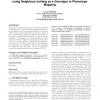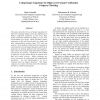138 search results - page 22 / 28 » Canonical representation genetic programming |
GECCO
2005
Springer
14 years 3 months ago
2005
Springer
Evolutionary relationships among species can be represented by a phylogenetic tree and inferred by optimising some measure of fitness, such as the statistical likelihood of the t...
CEC
2010
IEEE
13 years 1 months ago
2010
IEEE
— If a population of programs evolved not for a few hundred generations but for a few hundred thousand or more, could it generate more interesting behaviours and tackle more comp...
ISQED
2003
IEEE
14 years 3 months ago
2003
IEEE
This paper describes the use of integer equations for high level modeling digital circuits for application of formal verification properties at this level. Most formal verificatio...
CISS
2010
IEEE
13 years 1 months ago
2010
IEEE
—Frame permutation quantization (FPQ) is a new vector quantization technique using finite frames. In FPQ, a vector is encoded using a permutation source code to quantize its fra...
GECCO
2008
Springer
13 years 11 months ago
2008
Springer
This paper introduces a procedure based on genetic programming to evolve XSLT programs (usually called stylesheets or logicsheets). XSLT is a general purpose, document-oriented fu...


